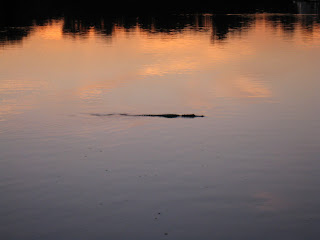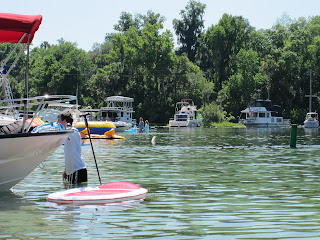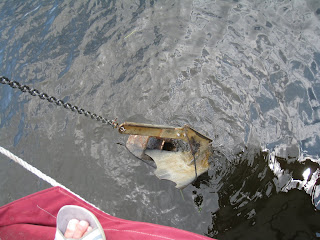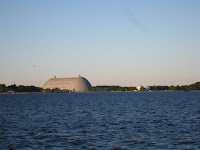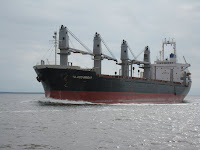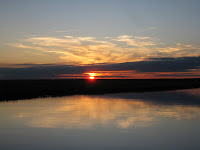We’ve been cruising long days and I’ve been too tired most nights to work on this blog, but tonight’s the night to catch up at least part way. I’ll start where I left off in the last blog.
May 6, 2011 Ft. McAllister Marina on the Ogeechee River
We watched Bailee’s softball game last night and then returned to the marina with the Hill family for a late dinner. Had a great time discussing Bailee’s athletic accomplishments.
We departed the marina about 1045 in the rain, and at 1150 rejoined the ICW, passing through Hell Gate (a notoriously shoaled area), crossed the Savannah River into South Carolina, and anchored in Bull Creek for the evening. As we were relaxing topside, a dinner-moonlight cruise passed by presumably out of one of the marinas on Hilton Head Island. They went up the river several miles while the sun was setting, then returned passing us on their way back. We’ve never experienced a dinner cruise up close and personal before!
Day: 7H05M – 47.8SM
Trip: 52H55M – 324.7SM
Saturday, May 7, 2011 Bull Creek, South Carolina
We were underway at 0805 in clear and sunny weather, crossed Port Royal Sound and passed Beaufort, South Carolina. We anchored for the night in Toogoodoo Creek after trying twice to get the anchor to hold. We’ve been here several times; the last time we experienced a tremendous thunder storm with winds up to 55 knots (and the anchor still held firmly). This time the weather was great – but the chart plotter stopped working while we were eating dinner (we leave it on for a few hours to ensure that we aren’t dragging the anchor). Nothing we could do would bring it back to life.
Day: 10H00M – 71.0SM
Trip: 62H55M – 444.1SM
Sunday, May 8, 2011 Toogoodoo Creek
We were underway at 0715 under clear skies. I did some checking online and on the boat and concluded that the fault with the chart plotter was with the unit and it would need to be sent in to Garmin for repair. In the meantime, we’d need another chart plotter, and while we were at it we might as well replace the topside VHF radio that was having some problems. I called West Marine in Charleston and Judy called a marina a few miles from West Marina. Between the two of us we arranged to buy a new chart plotter and VHF radio, and have them delivered to Ashley Marina where we could stop for an hour or so at no charge while we met the West Marine delivery person! Not bad for a morning’s work! We pulled in to Ashley’s at 1120, and by 1220 we had the new equipment and were on our way (it would have taken 1/2 the time but they charged me the non-sale price for the chart plotter so the person had to return to the store to straighten out the charge, and then return to get my signature).
We continued on for another few ours and anchored in Graham Creek about four hours north of Charleston on the ICW.
Day: 8H20M – 58.9SM
Trip: 71H15M – 531.0SM
May 9, 2011 Graham Creek Anchorage
We were underway at 0730 and I finished the installation of the new chart plotter and VHF while Judy was at the helm. Got everything connected (NMEA circuit feeding the laptop, radar, and auto-pilot) except the hailer (think I need a different one to work with the new VHF).
We passed through Winyah Bay near Georgetown, NC, and entered the Wacamaw River, anchoring for the night in an ox-bow named the Wacamaw River Anchorage.
Day: 8H45M – 64.lSM
Trip:80H00M – 595.1SM
Tuesday, May 10, 2011 Wacamaw River Anchorage
We were underway at 0720 and crossed into North Carolina at 1202. We caught a favorable tidal current for most of the afternoon, and tied our lines to the free dock at the Provision Company (a restaurant) in Southport, North Carolina, at the mouth of the Cape Fear River, at 1625. We had dinner at the restaurant, and helped several other boats tie up in the swift current.
Day: 9H00M – 66.9SM
Trip: 89H05M – 662.0SM
Wednesday, May 11, 2011 The Provision Company, Southport, NC
Lines off and underway at 0810 and headed up the Cape Fear River. We kept a good lookout but never did see either Robert Mitchum or Robert DeNiro! The tide was near slack, but the river current kept our speed to about 5.5 MPH the entire way up the river and into Snow’s Cut where the current was running about 3.0 MPH against us. We then had to wait about 30 minutes for the bridge at Wrightsville Beach (the bridge tender claimed she got distracted and forgot about us at the 1300 opening) and in less than 30 minutes I was taking the mast down in order to clear a 20 foot bridge a little further along; didn’t save much time, but at least I found all the pieces necessary to lower the mast and now have them stowed in a more accessible location.
We anchored for the night in Mile Hammock Bay at Camp LeJeune, North Carolina, along with 11 sailboats.
Day: 10H15M – 65.4SM
Trip: 99H20M – 727.4SM
Thursday, May 12, 2011 Mile Hammock Bay
After getting underway at 0725 we encountered a sailboat with an engine problem and towed it back to Mile Hammock Bay where the captain was going to try to fix the problem. Poor guy, he had just spent a week in a marina not too far away having a transmission replaced, and now there’s an engine problem. We were back on the way north about 0815 and continued on through Moorhead City and anchored for the evening at Oriental, North Carolina, in Smith Creek. We took the dinghy to the town dock, and had a nice meal ashore.
Day: 10H20M – 69.9SM
Trip: 121H40M – 797.3SM
Friday, May 13, 2011 Oriental
We were underway at 0715 down the Neuse River and then the Pamlico River. At 1420 we stopped at Dowry Creek Marina for fuel and took on 200 gallons to fill the tanks. Our fuel burn figured out to 1.65 gallons per hour. We also filled the water tanks, disposed of trash, and bought a T-shirt and some Klondike bars for desert!
When we prepared to leave the dock the bow thruster didn’t work, although it was working when we pulled into the dock. That’s not a big deal on a single engine boat, but it makes maneuvering a bit more difficult. Repairs had to wait until I gathered some information about what to do!
We anchored for the night at 1900 at Tuckahoe Point on the Alligator River after transiting the Pungo River-Alligator River Canal.
Day: 10H55M – 80.6SM
Trip: 133H25M – 878.2SM


